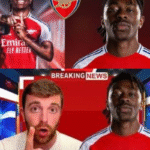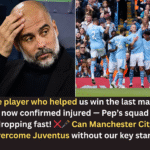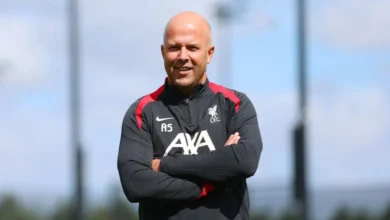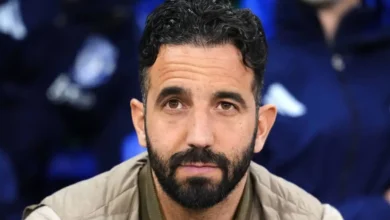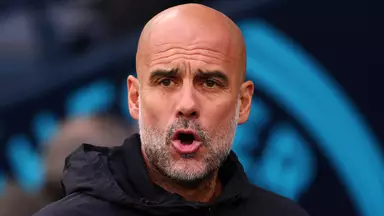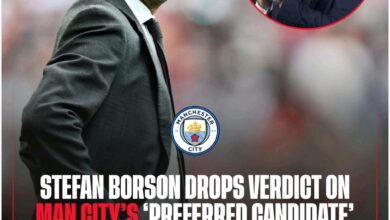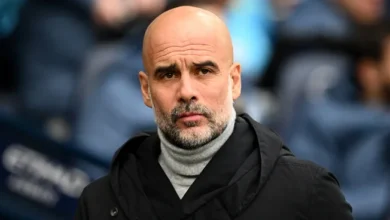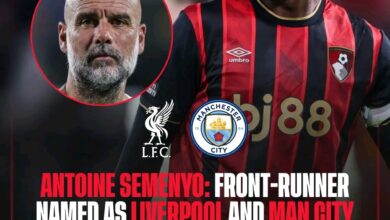Is Erling Haaland’s season over?! Man City striker sparks concern by leaving stadium in protective boot after ankle injury in FA Cup win at Bournemouth

Erling Haaland, the Norwegian forward for Manchester City, left fans and football enthusiasts worried after suffering an ankle injury during the team’s FA Cup quarter-final match against Bournemouth. The injury occurred on a day filled with drama, as Haaland netted his 30th goal of the season. Despite missing an early penalty that was saved by Bournemouth’s goalkeeper, Kepa Arrizabalaga, Haaland continued to contribute to the match until he was forced off the pitch just past the hour mark due to an injury. His departure from the game was seen as a significant moment, with concern growing over his condition and the potential impact on Manchester City’s season.
As the match unfolded, Haaland’s injury became a major talking point. After the striker hobbled off the field, it was clear that he was in pain, and he was replaced by Omar Marmoush, who would go on to score the match-winning goal. Haaland, who had been a driving force for City throughout the campaign, appeared to be struggling, and his injury raised immediate concerns about the severity of the issue. The situation became even more worrisome when Haaland was seen leaving the stadium on crutches, with a protective boot on his left foot, fueling speculation that the injury could be more serious than initially thought.
As the images of Haaland on crutches spread on social media, fans were quick to react, with many fearing that the star forward’s season might be over. Some supporters even went as far as to suggest that Manchester City’s hopes for the remainder of the season were in jeopardy without their top scorer. The sight of Haaland, the player who had been instrumental in City’s success, in such a condition left many feeling uncertain about the team’s future. For a team with aspirations in multiple competitions, the potential loss of their most prolific player was seen as a huge blow.
The media and fans alike speculated about the nature of Haaland’s injury. There was little official information about the extent of the damage, which only fueled the uncertainty. However, the fact that Haaland was wearing a protective boot and using crutches suggested that the injury could be significant, and many feared that he might be sidelined for an extended period. With no official word from Manchester City regarding how long Haaland would be out, the speculation about his recovery timeline continued to grow. The club had yet to provide any updates, which left the fans and the media waiting for more information.
For Haaland, the injury came at a critical point in the season. Manchester City had secured a place in their seventh consecutive FA Cup semi-final, but the team still had important fixtures in the Premier League and other competitions ahead. City’s next match was against Leicester City, followed by a crucial derby against Manchester United. These were matches where Haaland’s presence would have been invaluable, and the team faced an uncertain future without him. Haaland had been in remarkable form throughout the season, and his absence would leave a significant gap in the squad.
As Manchester City prepared for their upcoming fixtures, the injury to Haaland cast a shadow over their plans. The team had already faced challenges in their pursuit of multiple titles, and losing their top scorer at this point in the season added to the sense of uncertainty. Haaland had been instrumental in City’s attack, and without him, the team would need to adapt quickly if they were to continue their push for silverware.
Despite the growing fears, Manchester City remained tight-lipped about the situation. The club’s medical staff would undoubtedly be working to assess the damage and determine the best course of action for Haaland’s recovery. While the prospect of Haaland missing an extended period of time was concerning, the club would be hoping for a swift recovery to ensure that their star striker could return to action as soon as possible.
The uncertainty surrounding Haaland’s injury also raised questions about Manchester City’s depth and how the team would cope without their key player. While City boasted a talented squad with many options in attack, Haaland had been the focal point of their offensive play. His absence would place greater responsibility on other players to step up and fill the void. The team had shown resilience in the past, and they would need to dig deep to continue competing at the highest level without their talisman.
As fans anxiously awaited news on Haaland’s condition, the wider football world kept a close eye on the situation. Many wondered how long Haaland would be sidelined and whether Manchester City could maintain their form in his absence. The club had enjoyed considerable success in recent seasons, and Haaland’s presence had been a key factor in their dominance. His injury represented a significant challenge, but it also provided an opportunity for others to showcase their abilities and help the team in their pursuit of trophies.
In the days following the match, speculation about Haaland’s injury continued to dominate the headlines. Fans and pundits alike debated the potential impact of his absence on Manchester City’s campaign. Some suggested that the team might struggle to cope without Haaland’s goals, while others remained hopeful that the squad’s collective strength could see them through. The loss of a player like Haaland would undoubtedly be a setback, but the question remained whether Manchester City could continue their quest for success in the face of adversity.
Ultimately, the situation surrounding Haaland’s injury highlighted the unpredictable nature of football. A player who had been so central to Manchester City’s plans could suddenly find himself sidelined, and the team had to adapt to the changing circumstances. Haaland’s absence, if confirmed to be a long-term one, would represent a significant blow to the club’s aspirations, but it also underscored the importance of squad depth and the need for resilience in the face of injury setbacks.
For Haaland himself, the injury would be a frustrating setback in what had been an outstanding individual season. The striker had been in scintillating form, and his goals had been a key factor in Manchester City’s success. Missing out on the remainder of the season would undoubtedly be a disappointment for the Norwegian, but his focus would likely be on recovering fully and returning to the pitch as soon as possible.
In the meantime, Manchester City would be left to navigate the rest of the season without their star striker. Whether or not Haaland would return in time for the business end of the campaign remained uncertain, but the team would need to remain focused on their goals. The upcoming matches against Leicester City and Manchester United would be crucial, and the team would need to dig deep and find a way to continue performing at a high level in Haaland’s absence.
The situation was a reminder of how quickly fortunes can change in football. Just a few days prior, Manchester City had been celebrating their place in the FA Cup semi-final, and now they were facing an uncertain future without their most valuable player. In football, as in life, injuries are an unfortunate part of the game, and teams must adapt to overcome them. For Manchester City, the road ahead was uncertain, but they would remain hopeful that their star striker would recover and return to action soon. In the meantime, the team’s resilience and collective strength would be put to the test as they continued their pursuit of glory without Erling Haaland.


